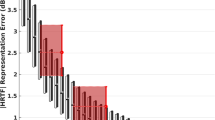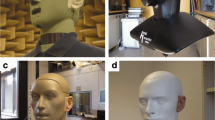Abstract
This study deals with the perceptual sensitivity to Head-Related Impulse Responses (HRIRs) in the median plane based on a series of subjective listening tests using a pair of headphones. First, the non-individualized HRIRs were modeled from 12 principal components (PCs) extracted from Principal Components Analysis (PCA) of the CIPIC HRTF database. The Just Noticeable Difference (JND) in weight of PCs (PCWs) at each elevation was estimated. It was not observed the common elevation-dependent tendency or PCW-dependent tendency of JND in PCWs across the five subjects who participated in the tests, and the inter-subject variation of JND in PCWs was large. The JND in HRIRs can be estimated indirectly from the JND in PCWs because the HRIRs can be represented by a linear summation of the PCs weighted by PCWs. The common elevation-dependent tendency of JND in Directional Impulse Responses (DIRs), which are the mean-subtracted HRIRs, across the five subjects can be found. The change in PCWs does not seem to contribute to our perception of sound source characteristics; however, the resulting change in HRIRs due to the change in PCWs seems to contribute. The subjects showed larger JND in DIRs in the frontal region than in the rear region. This means that our perception of sound source characteristics is more sensitive for frontal sources than rear sources.
Similar content being viewed by others
References
J, Blauert, Spatial hearing, MIT Press, Cambridge, MA, USA, (1983).
D. R. Begault, 3-D sound for virtual reality and multimedia, Academic Press, Cambridge, MA, USA, (1994).
D. J. Kistler and F. L. Wightman, A model of headrelated transfer functions based on principal components analysis and minimum-phase reconstruction, Journal of the Acoustical Society of America, 91 (1992) 1637–1647.
S. Hwang, Y. Park and Y. Park, Modeling and customization of head-related impulse responses based on general basis functions in time domain, Acta Acustica united with Acustica, 94 (2008) 965–980.
J.-W. Choi, HRTF-field reproduction for robust virtual source imaging, Journal of the Acoustical Society of Korea, 23 (2004) 324–332.
H.-Y. Kim, On the physical and perceptual precision of the multi-point control method in HRTF simulation, Journal of the Korean Society for Noise and Vibration Engineering, 18 (2008) 199–207.
R. D. Shilling and B. Shinn-Cunningham, Virtual auditory displays. In K. M. Stanney (Ed.), Handbook of virtual environments: Design, implementation, and applications. Mahwah, NJ: Erlbaum, USA (2002).
Y. Iwaya, Individualization of head-related transfer functions with tournament-style listening test: Listening with other’s ears, Acoustical Science and Technology, 27 (2006) 340–343.
A. Honda, H. Shibata, J. Gyoba, K. Saitou, Y. Iwaya and Y. Suzuki, Transfer effects on sound localization performances from playing a virtual three-dimensional auditory game, Applied Acoustics, 68 (2007) 885–896.
D. R. Begault and E. M. Wenzel, Techniques and applications for binaural sound manipulation in human-machine interfaces, International Journal of Aviation Psychology, 2 (1992) 1–22.
J. M. Loomis, R. G. Golledge, and R. L. Klatzky, Navigation System for the blind: Auditory display modes and guidance, Presence: Teleoperators and Virtual Environments, 7 (1998) 193–203.
S. Holland, D. Morse and H. Gedenryd, AudioGPS: Spatial audio navigation with a Minimal attention interface, Personal and Ubiquitous Computing, 6 (2002) 253–259.
A. B. Oving, J. A. Veltman and A. W. Bronkhorst, Effectiveness of 3-D audio for warnings in the cockpit, International Journal of Aviation Psychology, 14 (2004) 257–276.
R. S. Bolia, Special issues: Spatial audio displays for military aviation, International Journal of Aviation Psychology, 14 (2004) 233–238.
T. Lokki and M. Gröhn, Navigation with auditory cues in a virtual environment, IEEE Multimedia, 12 (2005) 80–86.
S.-J. Kwon, J.-H. Chun, S, Jang and M.-W. Suh, Driving performance analysis of the adaptive cruise controlled vehicle with a virtual reality simulation system, Journal of Mechanical Science and Technology, 20 (2006) 29–41.
J. Chen, B. D. Van Veen and K. E. Hecox, External ear transfer function modeling: A beamforming approach, Journal of the Acoustical Society of America, 92 (1992) 1933–1944.
M. A. Blommer and G. H. Wakefield, Pole-zero approximations for head-related transfer functions using a logarithmic error criterion, IEEE Transactions on Speech and Audio Processing, 5 (1997) 278–287.
J. Mackenzie, J. Huopaniemi, and V. Välimäki, Low-order modelling of head-related transfer functions using balanced model truncation, IEEE Signal Processing Letters, 4 (1997) 39–41.
Y. Haneda, S. Makino, Y. Kaneda and N. Kitawaki, Common-acoustical-pole and zero modeling of head-related transfer functions, IEEE Transactions on Speech and Audio Processing, 7 (1999) 188–196.
E. A. Durant and G. H. Wakefield, Efficient model Fitting using a genetic algorithm: Pole-zero approximations of HRTFs, IEEE Transactions on Speech and Audio Processing, 10 (2002) 18–27.
A. Kulkarni and H. S. Colburn, Infinite-impulseresponse models of the head-related transfer function, Journal of the Acoustical Society of America, 115 (2004) 1714–1728.
D. W. Grantham, J. A. Willhite, K. D. Frampton and D. H. Ashmead, Reduced order modeling of head related impulse responses for virtual acoustic displays, Journal of the Acoustical Society of America, 117 (2005) 3116–3125.
W. L. Martens, Principal components analysis and resynthesis of spectral cues to perceived direction, Proc. of International Computer Music Conference, San Francisco, CA, USA, (1987) 274–281.
J. C. Middlebrooks and D. M. Green, Observations on a principal components analysis of headrelated transfer functions, Journal of the Acoustical Society of America, 92 (1992) 597–599.
J. Chen, B. D. Van Veen and K. E. Hecox, A spatial feature extraction and regularization model for the head-related transfer function, Journal of the Acoustical Society of America, 97 (1995) 439–452.
Z. Wu, F. H. Y. Chan, F. K. Lam and J. C. K. Chan, A time domain binaural model based on spatial feature extraction for the head-related transfer function, Journal of the Acoustical Society of America, 102 (1997) 2211–2218.
K. Shin and Y. Park, Enhanced vertical perception through head-related impulse response customization based on pinna response tuning in the median plane, IEICE Transactions on Fundamentals, E91-A (2008) 345–356.
S. Hwang and Y. Park, Interpretations on principal components analysis of head-related impulse responses in the median plane, Journal of the Acoustical Society of America, 123 (2008) EL65–71.
V. R. Algazi, R. O. Duda, D. M. Thompson and C. Avendano, The CIPIC HRTF database, Proc. of the 2001 IEEE ASSP Workshop on Applications of Signal Processing to Audio and Acoustics, New Paltz, NY, USA, (2001) 99–102.
S. Hwang and Y. Park, HRIR customization in the median plane via principal components analysis, Proc. of the 31st International Audio Engineering Society conference, London, UK, (2007).
H. Møller, Fundamentals of binaural technology, Applied Acoustics, 36 (1992) 171–218.
H. Møller, D. Hammershøi, C. B. Jensen and M. F. Sørensen, Transfer characteristics of headphones measured on human ears, Journal of the Audio Engineering Society, 43 (1995) 203–217.
A. Kulkarni and H. S. Colburn, Variability in the characterization of the headphone transfer-function, Journal of the Acoustical Society of America, 107 (2000) 1071–1074.
Author information
Authors and Affiliations
Corresponding author
Additional information
This paper was recommended for publication in revised form by Associate Editor Yeon June Kang
Sungmok Hwang received his B.S. degree in Mechanical Engineering from Yonsei University, South Korea, in 2004. He then received his M.S. and Ph.D. degrees from KAIST in 2006 and 2009, respectively. Dr. Hwang is currently a senior research engineer at Marine Research Institute, Samsung Heavy Industries. His research interests include sound and vibration control, audio signal processing, robot auditory system, binaural synthesis.
Youngjin Park received his B.S. and M.S. degrees in Mechanical Engineering from Seoul National University, South Korea, in 1980 and 1982, respectively. He then received his Ph.D. degree in Mechanical Engineering from University of Michigan, USA, in 1987. From 1987 to 1988, he worked as a research fellow at University of Michigan. He also worked as an assistant professor at NJIT, NJ, from 1988 to 1990. He joined the faculty of KAIST in 1990, where he is a Professor of Mechanical Engineering. His research interests include general control theories, virtual audio synthesis, active control of noise and vibration, system identification.
Youn-sik Park received his B.S. degree in Mechanical Engineering from Seoul National University, South Korea, in 1972. He then received his M.S. and Ph.D. degrees in Engineering Mechanics from Iowa State University, USA, in 1979 and 1981, respectively. From 1981 to 1984, he worked as a senior researcher at KAIST. He joined the faculty of KAIST in 1984, where he is a Professor of Mechanical Engineering. His research interests include vibration dynamics, system identification, experimental and analytical modal analysis, machine and manipulator dynamics.
Rights and permissions
About this article
Cite this article
Hwang, S., Park, Y. & Park, Ys. Analysis on perceptual sensitivity to head-related impulse responses in the median plane. J Mech Sci Technol 23, 3340–3348 (2009). https://doi.org/10.1007/s12206-009-0925-z
Received:
Revised:
Accepted:
Published:
Issue Date:
DOI: https://doi.org/10.1007/s12206-009-0925-z




